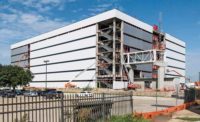Initially identified in the early 1990s as an area to redevelop under a master thoroughfare plan, a critical intersection in Sugar Land, Texas, is finally being transformed. Teams led by two different general contractors on the University Boulevard North Extension project are orchestrating work around a handful of major stakeholders, while also facing poor soil conditions that challenged engineers and constructors on critical segments.
The project is a four-lane, divided, north-south connector that extends University Boulevard north from the US 90A intersection along the west edge of the business campus of Nalco Champion, a supplier to the oil and gas industry. A new bridge will carry the route over Oyster Creek and a Union Pacific Railroad (UPRR) spur before finally merging with Stadium Drive, which runs along the city’s newly built baseball park, Constellation Field.
Construction scope includes an at-grade rail crossing with traffic signal preemption, a 510-ft-long grade-separated overpass, a shared-use path and sidewalk, retaining walls and a bridge-supported water line.
“This road segment is a key connection from the north side of town across the railroad tracks to the south side of town and actually transitions to University Boulevard south of US 90A, which continues all the way around and acts as a bypass around the State Highway 6 corridor,” explains Christopher Steubing, city engineer with the city of Sugar Land, the project owner.
The roadway will improve access from north Sugar Land to south of US 90A while also providing an alternate route to alleviate traffic congestion.
Development of the surrounding area, including the start of Constellation Field’s construction in 2011, further propelled the city to move forward on the extension. But first the city had to satisfy the needs of the affected stakeholders—the Texas Dept. of Transportation (TxDOT), UPRR, Johnson Development and Nalco Champion.
“We had a development agreement with UPRR,” Steubing says. “They needed some easements for a double-tracking project they were doing; we wanted a new crossing. So we signed an agreement with them that allowed us a new crossing.”
“It would close Nalco’s private drive and one other public crossing. We also have a development agreement with Nalco, which now has two new driveways off the new segment of roadway and a brand new five story office building right off it, where they’ve moved 1,200 jobs into the community.”
Following negotiations with various entities, the city and engineer-of-record Lockwood, Andrews & Newnam Inc. (LAN) began design and preliminary engineering in 2014. Construction on the road segment started in September 2015, the rail section in May 2016 and the bridge segment in January.
The roughly $21-million project includes about 850 ft of US 90A, 2,550 ft of S Stadium Drive, 510 ft of bridge and 1,880 ft of rail work.
The city split the project into three work packages: bridge, roadway and rail. Webber LLC won the contract to serve as general contractor for the rail relocation, while Harper Brothers Construction (HBC) won the road and bridge contracts.
“We considered using some alternative delivery on the bridge side, but we’ve been seeing aggressive pricing from our contract engineering, so we went through design-bid-build,” Steubing says.
Building on Sand
One of the project’s major problems was the ground itself.
“Sugar Land has very sporadic ground conditions,” explains Jon Harper, CEO of HBC, describing the area’s underground conditions as “very sandy, soft and wet. Those are tough conditions to build anything, but specifically the foundations and the bridge abutment itself.”
Placing the storm sewer pipe challenged contractors because the bearing capacity of the soil proved insufficient to support the reinforced concrete pipe. To accommodate the roadway’s drainage installation along the south side of a creek, crews installed a structural seal slab, explains Keisha Seals, the city’s project manager.
“The soils along the entire limits of the project are poor and required deeper piers for the bridge as well as the CMC foundations for the retaining wall to reduce settlement,” she says.
Engineering for a bridge crossing over UPRR’s spur, where a minimum 23-ft floor clearance was required, was further complicated by the poor soils, adds Lauren VanAndel, bridge section leader at LAN.
“UPRR’s spur does a loop around this project, so we’re crossing UP at grade on the south side and doing a grade separation on the north side,” she says. Considering the 23-ft floor clearance minimum over the railroad, plus the superstructure and bridge deck, the “road is pretty high at that point, and we had to balance where to start the bridge, where to end the embankment, the approach embankment and the retaining walls,” VanAndel explains.
While a 30-ft retaining wall would be possible, the soils would be unable to provide appropriate support, so significant foundation improvements were needed.
“We ended up capping the retaining wall at 25 ft, and we looked into two different options with improving the foundation.”
– Lauren VanAndel, LAN
“We ended up capping the retaining wall at 25 ft, and we looked into two different options with improving the foundation,” VanAndel says.
One option was the standard remove and replace with cement-stabilized sand, which would have required the replacement of about 8 ft of soil. Instead, LAN opted to place rigid inclusions, which are grout columns spaced closely throughout the embankment area.
“These rigid inclusions are definitely much more stout, but are a much more costly foundation improvement method,” she notes. “There was about 20 ft of soil that practically has no bearing capacity, so if you put a heavy load on something that can’t hold it, it’s just going to sink.”
Hayward Baker installed a CMC rigid inclusion foundation under the abutment, Harper says.
The rigid inclusions cover about 30,000 sq ft of embankment area with 1,775 12-in.-dia columns. Meanwhile, the retaining wall foundations, filled with mechanically stabilized earth, span almost 25,000 sq ft.
Without the inclusions, the resulting settlement would have been about 5 in., VanAndel adds.
Water Transmission
According to project team members, the bridge is comprised of reinforced concrete bents and abutments, with Tx54 girders and drilled shafts. Above, the bridge deck spans 34,029 sq ft, along with 4,500 linear ft of Tx54 girders.
HBC had to install drill shaft foundations in the water of Oyster Creek, Harper says. The team utilized a temporary cofferdam to help with that process.
On the bridge itself, teams had to include a water transmission line, which included about 1,600 linear ft of 12-in.-dia pipe. The team used steel pipe on the bridge itself, then PVC past the bridge.
Johnson Development is planning to develop land west of the project and south of the creek, so the project team is bringing a water line over the water rather than under it, which would have been far more expensive, VanAndel explains.
But to take that pipe up the full elevation of the bridge meant handling several issues. The water line had to be pressurized in order to go up the bridge, while the agreement with UPRR discouraged the placement of any kind of utilities on the bridge because it’s going over their railway, VanAndel says.
Under the agreement, the team added a casing to the water line that spans the railroad’s entire right-of-way.
“The problem with that though is we’re going up and over, and the highest point of the bridge goes right over the top of UPRR, because that’s where we need to have the vertical clearance,” VanAndel says. “When you do a water line and you have a vertical curve on your water line, that water has to have an air release valve, and you can’t put that air release valve where you have casing.”
That required ensuring that the high point of the water line was outside the railroad’s right-of-way, so the air release valve could be in a place without the casing.
Aesthetic elements on the bridge also hindered the water line’s placement on top of or alongside the overhang, VanAndel says.
As a result, engineers used a “little geometry workaround” to hide the water line inside one of the bridge’s interior bays, VanAndel says.
To do that, “we designed special hangers and rollers to support the 12-in. steel water line to be placed between the Tx54 girders,” Harper says. “We’ve installed many aerial water lines but never between the beams. It took a lot of engineering and brainstorming.”
Additional Solutions
When the project first began, the scope did not include rebuilding a section of US 90A.
In fact, when LAN started developing the project’s profile, US 90A didn’t correlate well with the rail location, VanAndel explains.
Because the rail line was higher than US 90A, that alignment would have resulted in “a big dip and a huge bump in the road” for travelers over the railroad. “We ended up rebuilding about 500 ft on each side of US 90A,” she says.
The project’s railroad crossing required closing two existing crossings and field diagnostic reviews with UPRR, the Federal Railroad Administration, TxDOT and the city of Sugar Land.
Under the rail segment’s scope, Webber relocated the alignment of the existing rail spur off the UPRR main line into Nalco’s facility, says Thomas Arbuthnot, the contractor’s senior project manager. This included 1,300 ft of construction consisting of wood ties, rail installation, surfacing and track removal, as well as civil site work.
“UPRR constructed the tie-ins on either end of the track, and getting them scheduled was very difficult at the right time,” he says. Teams also had to work next to the existing active rail line, requiring crews to move each time a train passed.
Meanwhile, the city also relocated the spur out front and elevated it about 3 ft to match the existing rail elevations of the double-track that was there, says Steubing.
The first and second work packages, rail and road, are now complete, while the third, the bridge, is on track to wrap up in February. Webber completed the rail section with 5,587 worker hours and zero safety incidents or lost time, while HBC finished the road section with 25,194 worker hours, also with zero incidents or lost time. As of mid-May, HBC’s team had clocked 3,900 worker hours on the bridge section.








Post a comment to this article
Report Abusive Comment